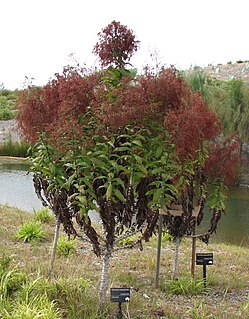
The Vitaceae are a family of dicotyledonous flowering plants, with 14 genera and ca 910 known species, including the grapevine and Virginia creeper. The family name is derived from the genus Vitis. The name sometimes appears as Vitidaceae, but Vitaceae is a conserved name and therefore has priority over both Vitidaceae and another name sometimes found in the older literature, Ampelidaceae. In the APG III system (2009) onwards, the family is placed in its own order, Vitales. Molecular phylogenetic studies place the Vitales as the most basal clade in the rosids.

Hydnoroideae is a subfamily of parasitic flowering plants in the order Piperales. Traditionally, and as recently as the APG III system it given family rank under the name Hydnoraceae. It is now submerged in the Aristolochiaceae. It contains two genera, Hydnora and Prosopanche:

Prunus africana, the African cherry, has a wide distribution in Africa, occurring in montane regions of central and southern Africa and on the islands of Bioko, São-Tomé, Grande Comore, and Madagascar. It can be found at 900–3,400 m (3,000–10,000 ft) above sea level. It is a canopy tree 30–40 m in height, and is the tallest member of Prunus. Large-diameter trees have impressive, spreading crowns. It requires a moist climate, 900–3,400 mm (35–130 in) annual rainfall, and is moderately frost-tolerant. P. africana appears to be a light-demanding, secondary-forest species.

Leea is a genus of plants that are distributed throughout Northern and eastern Australia, New Guinea, South and Southeast Asia and parts of Africa. Leea contains approximately 70 species and is placed in the Vitaceae family. The APG IV system places Leea in the subfamily Leeoideae (Vitaceae). Leea is often placed in its own family, Leeaceae, based on morphological differences between it and Vitaceae. These differences include ovule number per locule, carpel number, and the absence or presence of a staminoidal tube and floral disc. Pollen structure has also been examined for taxonomic demarcation, though studies have concluded that the pollen of Leeaceae and Vitaceae suggests the families should remain separate while other studies conclude that Leea should be included in Vitaceae.

Xylopia africana is a species of plant in the Annonaceae family. It is found in west-central Africa. It is restricted to submontane and lower montane forests. It is threatened due to habitat loss by clearance of forest. It was first described as Melodorum africanum in 1862 by George Bentham.

Calomeria is a plant genus in the dandelion family.
Ampelocissus xizangensis is a deciduous vine in the Vitaceae family, native to shrublands in the high valleys of the Tibet Autonomous Region and Nepal, at elevations about 2000 m high.

Galenia is a genus of low growing perennial herbs in the family Aizoaceae. The genus is endemic to southern Africa.

Ampelocissus is a genus of Vitaceae having 90 or more species found variously in tropical Africa, Asia, Central America, and Oceania. The type species, A. latifolia, was originally treated under its basionym, Vitis latifolia, and was collected from the Indian subcontinent.
Craspedorhachis is a genus of African plants in the grass family.
Ampelocissus acetosa is a species of vine. Common names include wild grape and djabaru.

Ampelocissus latifolia is a plant in the Vitoideae subfamily of the grape family native to the Indian subcontinent.
Ampelocissus abyssinica is a large climbing vine native to southeast Ethiopia, where it is known in the Afaan Oromo language by the name teru, and is used as a herbal treatment for the medical condition known as black leg. Its first botanical description was in 1847 as Vitis abyssinica, that name being the basionym for its treatment here under the genus Ampelocissus.
Ampelocissus winkleri is a woody climbing vine, or liana in the grape family Vitaceae native to the island of Borneo. It was described botanically in 1910.
Ampelocissus concinna is a climbing vine or liana in the grape family native to Angola.
Ampelocissus gracilipes, also known as abourbee (Akan-Twi), is a climbing vine or liana in the Grape family of tropical western Africa, in densely vegetative, forested areas.
A. africana may refer to:
Ampelocissus barbata is a species of liana in the grape family Vitaceae. It was originally described from Sylhet by Nathaniel Wallich and placed in the genus Vitis. The species was moved to Ampelocissus by Jules Émile Planchon in 1884.

Rhoicissus rhomboidea is a climbing plant in the family Vitaceae, commonly known as the glossy forest grape. It is found in the eastern forests of southern Africa. The species was first described in 1859, treated under Cissus.

Ampelocissus asekii is a species of vine, in the family Vitaceae, from Morobe Province of Papua New Guinea. It is a close relative of Ampelocissus muelleriana Planch., another endemic of New Guinea and differs from the latter by its densely woolly tomentose lower leaflet surface and much thicker leaflets. The species is from the mid montane forests, whereas A. muelleriana occurs in the lowland rain forests. It is named after the type locality, the Aseki Patrol area in Morobe Province and was first described in 2013.









